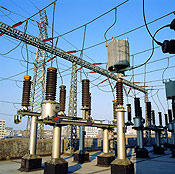
China is increasing electricity exchanges across different regional grids to deal with the nation's worst electricity shortage in two decades.
Supplies from electricity-rich areas to power-pinched areas, such as eastern and southern China, surged by 223 per cent year-on-year in the first six months of 2004 to 28.6 billion kilowatthours, said the State Grid Corp. The company oversees most of the nation's transmission assets, except those in the south of the country.
Electricity exchanges between different provinces in the same regional grids increased by 24.5 per cent to 59.5 billion kilowatt-hours in the first half of this year, according to the company.
The power exchange surge was attributed to the completion of several transmission lines during the period, including a 500-kilovolt direct current transmission line from the Three Gorges to Guangdong Province, the expansion of the transmission line from the Three Gorges to East China's Jiangsu Province, a second transmission line from Northeast China Grid to the North China Grid, and a second line from the Sichuan and Chongqing Grid to East China.
The electricity flow from power-rich regions has helped alleviate the severe electricity shortage in China's economic powerhouses of Guangdong and eastern China such as Shanghai, Jiangsu and Zhejiang provinces. The regions are the areas most seriously hit by a nationwide power crunch that has already swept over two-thirds of the nation.
External electricity supply to East China Grid now accounts for 10 per cent of the region's total consumption. Guangdong also purchases more than 10 per cent of its electricity from neighbouring areas such as Guizhou and Yunnan provinces.
Ye Rongsi, vice-president of the China Electricity Council, said electricity exchanges will become more common as grid companies strengthen the links between separate regional grids.
"Although it cannot fully address the electricity shortage, power exchanges do serve as a way to promote the optimization of resources," said Ye.
Ye said the power exchange projects will help eastern areas to take the advantage of the rich power resources in those western areas, easing their hunger for electricity, while allowing western regions to develop their local economies.
China now has seven regional grids, covering Northeast China, Northwest China, East China, Central China, North China, Sichuan and Chongqing, and South China, and five independent provincial grids on the mainland. The connection between regional grids are so fragile that cross-regional power exchanges only account for less than 3 per cent of total electricity generation.
China's grid companies are investing billions of dollars in promoting the connection of power grids and establish a consolidated national network by 2010.
State Grid said it will intensify electricity exchanges during the summer, the seasonal consumption hike. The company plans to supply 11.5 billion kilowatthours of electricity during the July-September period to the East China Grid. This is an almost 20 per cent increase compared to the amount supplied during the same period last year.
State Grid had earlier said that electricity exchange is expected to increase to 54.3 billion kilowatt-hours by the end of the year, a 66.7 per cent rise over last year.
This amount will further increase to 120 billion kilowatt-hours by 2010.
(China Daily August 6, 2004)
|

